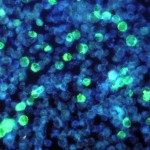Link to Pubmed [PMID] – 12586624
Blood 2003 Jun;101(12):4887-93
Several distinct classes of surface receptors can, on ligand binding, transmit signals that modulate the survival, proliferation, and apoptosis of peripheral B, T, and natural killer (NK) cells. At the population level, dynamic changes in lymphocyte cell numbers are strictly regulated to maintain a steady state, a process referred to as homeostasis. Although several studies have investigated the signals that regulate B- and T-cell homeostasis, little is known about the mechanisms that control the survival and proliferation of peripheral NK cells. Using an adoptive transfer system, we have investigated the role of gammac-dependent cytokines, in particular interleukin 7 (IL-7) and IL-15, and major histocompatibility complex (MHC) class I molecules in peripheral NK-cell homeostasis. We observed that IL-15 plays a dominant role in the survival of peripheral NK cells, via maintenance of the antiapoptotic factor Bcl-2. IL-15 availability, however, also plays an important role because endogenous NK cells in the recipient mice influence the behavior of adoptively transferred NK cells. Finally, although NK cells bear functional inhibitory Ly49 receptors for MHC class I molecules, the presence or absence of specific ligands on host cells did not influence the survival or homeostatic expansion of donor NK cells.
